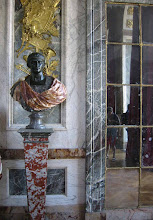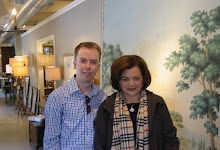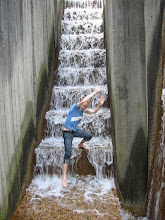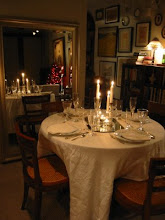Nestled at the top of the hilltop Borghese Gardens the villa was built as a suburban party house for Cardinal Scipione Borghese (nephew to Pope Paul V) by architect Flaminio Ponzio in 1613.
Built to house Borghese's large art collection, the villa was never meant to be a home. Rather it has always been filled with precious artworks by Bernini, Caravaggio, Titian, Raphael, Rubens and others; a veritable art history lesson under one roof.
Because I'm obsessed with floorplans I had to include these plans of the Villa. Above is the piano nobile or main floor which houses the bulk of the sculpture collection while the 2nd floor (or first floor to Europeans) houses the main painting collection. The ground basement level holds the typical museum cafe, giftshop, tickets, and offices.
The building itself is so ornate the artwork is almost secondary, despite being MAJOR art. I'm serious when I say it literally took my breathe away stepping into the first gallery and all of the people around me (there is timed entry with every group allotted 2 hours and you need every second of it). One enters through a rather plain stone basement and up a spare round stone staircase into the 2nd largest room in the villa (shown on the first floorplan as room IV)
I didn't even notice the artwork for the first hour; I was checking out the murals covering every surface of every room.After I became adjusted to this level of opulence I started to notice the sculpture. Bernini, possibly the greatest sculptor ever born in my opinion, has a major work in the center of most every room of the piano nobile. I will admit that sculpture isn't my favorite art form (I often find it boring) but these were INCREDIBLE and lifelike.
Gallery IV in the images above displays Bernini's "Rape of Proserpina" from 1622.
The walls when not covered in mosaics or frescoes feature marble paneling in numerous stones and all thoughtfully joined. Notice how the striped marble 'sticking' lines up into a rectangle in the corner. Wow. More on this later.
This is still just the first room! There is so much to see it can't all be captured in one or two photographs and each room, no matter the size, contained this level of detail.
The smaller galleries are also thoughtfully arranged, typically topically (say that three times fast...typically topically, typically topically....). Notice the symmetrical arrangement of the decoration and collections. Doorways are 'faked' to keep each wall elevation symmetrical with artwork perfectly centered in front.
Above is the first sculpture Borghese commissioned from Bernini, "Aeneas, Anchises, and Ascanius" in 1618 when the sculptor was only 20 years old. What were you doing at 20? I'm guessing not this, I certainly wasn't.
There are no words.....
Notice the foreshortening and perspective painted into the false door above.
A pair of smiling sphinxs were my favorite thing in this Egyptian revival room.
In some of the smaller rooms the marble paneling is actually faux painted plaster. It was sometimes hard to tell which was which!
Notice the drunken Satyrs in the ceiling painting below; remember this is a party pavilion!
Not all of the wall decorations are painted however -notice the horse sculpture and water maidens above the doorway below - connecting the main level gallery to room #IV
It wasn't until the late 18th century that the gallery became fully open to the general public and it has remained so since.
This playful wall painting below with monkeys is probably my favorite room; notice the lovely candle sconce as well on the left.
Even the covered porch or loggia is heavily decorated and full of precious sculpture.
The work of art I was most familiar with was Antonio Canovas' life-sized"Venus Victrix" or Venus Victorious modeled by Pauline Bonaparte / Borghese in 1808. Interesting to note that the base is actually painted wood and the marble is waxed so that it appears more lifelike.
Below is Bernini's "David" from 1624. Compare this to the more famous David by Michelangelo and you will understand Bernini. Movement is everything, which in turn makes the sculpture appear more lifelike. Michelangelo's "David" is static and though while beautiful, far from life-like.
This bust below before the almost modern looking doors may have been my favorite 'moment' in the museum.
My favorite sculpture, if I had to chose just one, was Bernini's "Apollo and Daphne" from 1625. In the story Daphne changes into a tree (Metamorphosis) and the sculpture captures the moment. This was by far the most crowded sculpture to try to see in the villa.
The entire room is themed on the sculpture which is reflected in the ceiling mural as well as the other sculptures in the room.
Amazing and beautiful from every angle. Below is the ceiling depicting the event directly above the sculpture which blogger won't let me turn...grrrrr.
Below is Jean-Antoine Houdon's very intense plaster sculpture of St John the Baptist. Can't you feel him reaching out even through the photograph?
Just anther pretty ceiling.
You can see the Villa hasn't changed much and been lovingly restored by comparing the top photograph to the 300 year old painting below.
Lovely finishes abound.
These are faux marble walls below with a granite topped table and marble urn. The Borgheses were not known for being minimalists.
Below is the main picture gallery on the 2nd floor (room XIV in the plan above)
I loved these built in consoles: painted wood brackets with marble tops.
I wonder what painting was missing below -such a large hook?
The rather comical "Allegory of the discovery of America" below by Jacopo Zucchi in 1585.
I admit to visual exhaustion by the time I got to the second level and not paying as much attention to the paintings as I should.
Although I was captivated by these painted doors below.
They remind me of the doors I saw at Architectural Accents in Atlanta last year (post HERE).
Notice how the plaster walls on the 2nd floor exactly match the marble detailing below - all faux!
If you have future plans to visit Rome, give yourself a few weeks to buy your tickets beforehand to visit the Galleria Borghese. The surrounding gardens are a lovely way to spend a Roman (holi-)day.
















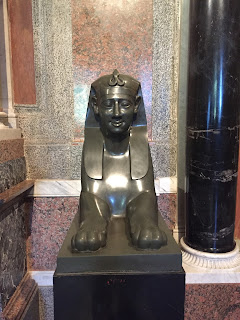







































































.JPG)



























































